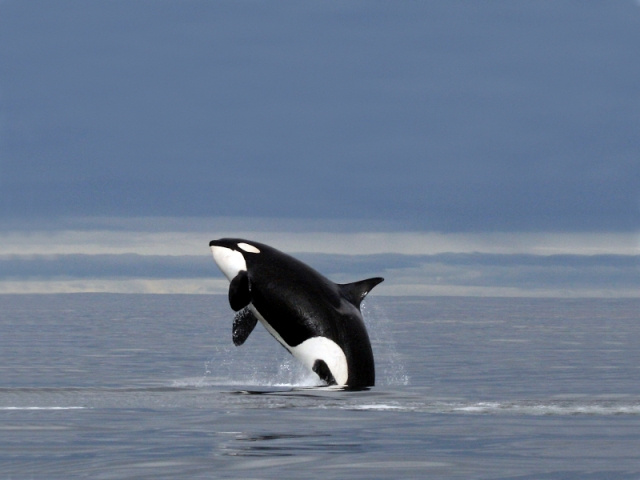Orca, Killer Whale
Orca, Killer Whale (Orcinus orca)Spanish name: Orca Comun, Espolante

More about Orca, Killer Whale
Habitat
Open tropical, temperate, and polar seas are home to the orca; occasionally it swims into bays, estuaries, or the mouths of a river, and can be abundant in cold waters more than 800 km away from the shore.
Range
The orca is found in all open seas.
Physical Description
The orca's back is black with a gray spot behind the dorsal fin; in contrast, its chin, throat, belly, and the lower part of the flukes are white, as is a large spot behind the eye. The head is rounded with a conical snout and 40-48 sharp teeth. The dorsal fin of the male is a tall skinny triangle, about 1.8 m long; the female's dorsal fin is smaller and more curved.
Interesting Biology
One of the most loved and trained whales, the orca is appropriately also known as the killer whale-in the wild, this strikingly beautiful animal is an efficient, cooperative hunter. The equivalent of a wolf in the sea, the orca lives within a complex social structure, in which echolocation is used for social communication as well as finding obstacles and prey. Their stable pods are tightly bonded, with up to 30 individuals; sometimes pods merge temporarily into herds of hundreds of whales.
Admired for its grace and agility in captivity, orcas can be seen breaching in the ocean, enthusiastically slapping the water with reentry. This whale generally makes short dives for 10-30 seconds, but can dive down to 260 m. Usually swimming at 6-10 km/hr, it can reach speeds of 40 km/hr.
A female will birth one calf after a 15-month gestation and nurse it for 1 year, and gradually wean it for a year after that. They wait 3-8 years between births, so when these whales are targeted, their populations take a long time to recover. Although they are a protected species, they are still hunted in Japan for meat.
Diet
In a single day, an orca can eat 4% of its large body weight, by hunting fish such as herring, cod, or salmon, as well as squid, octopus, seals, sea birds, otters and penguins.
Height/Weight
The male of this species may reach 9.5 m in length and weigh more than 6 tons; the female is usually less than 7 m long, and weighs only four tons.
Brief Taxonomy
Order: Cetacea
Family: Delphinidae
Sources
Saenz, Joel C., Grace Wong, and Eduardo Carrillo. Ballenas y delfines de America Central. Instituto Nacional de Biodiversidad. Costa Rica, 2004.
-Amy Strieter, Wildlife Writer
Orca, Killer Whale Sightings
Similar Profiles
It's more than just having a good time or visiting beautiful places (although that's absolutely a part of it!), it's about being part of a unique experience that stays with you.



